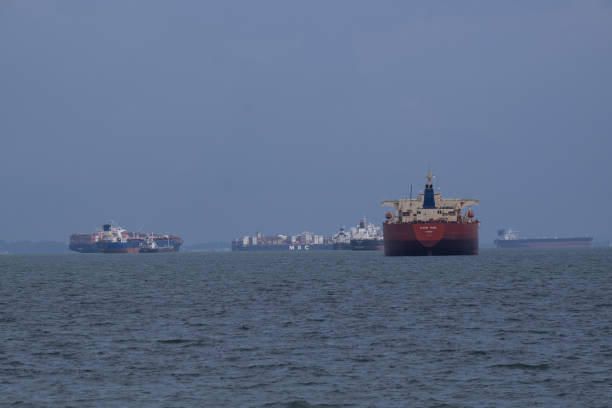Singapore’s container port is experiencing its worst congestion since the COVID-19 pandemic, with vessels re-routing to avoid Red Sea attacks causing significant disruptions to global ocean shipping. This has led to severe bottlenecks in ports across Asia and Europe, impacting retailers, manufacturers, and other industries reliant on massive box ships. As these industries prepare for the peak year-end shopping season, they are grappling with surging rates, port backups, and shortages of empty containers.
Maritime data firm Linerlytica reported that global port congestion has reached an 18-month high, with 60 per cent of ships waiting at anchor located in Asia. As of mid-June, ships with a total capacity of over 2.4 million twenty-foot equivalent units (TEUs) were waiting at anchorages. Unlike during the pandemic, it is not a consumer buying spree causing these delays but rather disruptions in ship timetables. Vessels are missing sailing schedules and making fewer port calls as they take longer routes around Africa to avoid the Red Sea, where Yemen’s Houthi group has been attacking shipping since November.
Table of Contents
Transhipment Hubs Overwhelmed in Singapore
The rerouting of vessels has resulted in ships offloading larger quantities at major transhipment hubs like Singapore. This approach helps shippers manage missed sailing schedules and fewer port calls but leads to significant congestion. Jayendu Krishna, deputy head of Drewry Maritime Advisors, explains that liners have been accumulating containers in Singapore and other hubs to cope with these delays.
From January to May, the average cargo offload volume in Singapore jumped by 22 per cent, significantly impacting port productivity. Singapore, the world’s second-largest container port, has seen average wait times to berth a ship increase to two to three days, with some delays lasting up to a week, according to the Maritime and Port Authority (MPA) and container trackers Linerlytica and PortCast. Typically, berthing should take less than a day. Neighbouring ports in Malaysia and China, such as Port Klang, Tanjung Pelepas, Shanghai, and Qingdao, are also experiencing increased wait times.
Drewry anticipates that congestion at major transhipment ports will remain high but expects some easing as carriers add capacity and restore schedules. Singapore’s MPA announced that port operator PSA had reopened older berths and yards at Keppel Terminal and would open more berths at Tuas Port to address extended waits.
Peak Season Intensifies Strain
The annual peak shipping season has arrived earlier than expected, further exacerbating congestion. Restocking activities, especially in the U.S., and early shipping in anticipation of higher demand have driven this early peak season. Niki Frank, CEO of DHL Global Forwarding Asia Pacific, notes that customers are shipping goods early in anticipation of stronger demand, intensifying the strain on ports.
Container rates have surged, reminiscent of the post-pandemic inflation spike. Rates stabilised into April but saw a significant increase in May due to higher exports of Chinese e-commerce, electric vehicles, and renewable energy-related goods, according to Asia-focused freight forwarder Dimerco. The peak season, traditionally starting in June, began a month earlier this year, causing ocean freight rates to triple since early 2024.
According to Descartes data, container import volumes at the 10 largest U.S. seaports rose by 12 per cent in May, marking the second-highest monthly import volumes since January 2023. Jonathan Gold, a National Retail Federation vice president, attributed this to continued high consumer spending and retailers stocking up to meet demand.
Ocean imports into Europe from Asia also show signs of restocking running into peak season, pushing rates to 2024 highs. Judah Levine of freight platform Freightos notes that container freight prices from Asia to the U.S. and Europe have tripled since early 2024.
Future Outlook and Economic Impacts
Some industry players believe the bottlenecks at Chinese ports are driven by U.S. importers rushing to buy goods subject to tariff hikes starting on August 1. However, newly imposed U.S. tariffs would affect only about 4 per cent of Chinese imports, stated Jared Bernstein, chair of the Council of Economic Advisers. Concerns about potential strikes at U.S. ports and German port strikes are adding to the gridlock.
Experts warn that these disruptions will likely mean higher prices for consumers globally. The ripple effects of port congestion and increased shipping costs are expected to spread through supply chains, impacting the prices of goods worldwide. As industries and consumers brace for the peak season, the global shipping landscape remains strained, with no immediate relief in sight.
